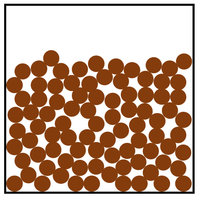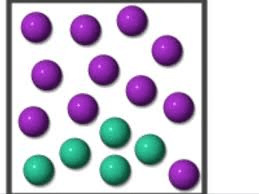What are the two units used in Chemistry to describe temperature?
Celsius (C) and Kelvin (K)
Which of the three phases of matter, does the particle diagram below represent?

It represents a liquid.
Which type of matter is composed of two or more different elements chemically combined in a fixed ratio?
(a) a solution
(b) a compound
(c) homogeneous mixture
(d) heterogeneous mixture
(b) a compound
By using a paper filter, which of the following can be separated?
(a) two immiscible liquids
(b) a solid in a liquid
(c) two heterogeneous solids
(d) two miscible liquids
(b) a solid in a liquid
An object has a density of 2.33 g/cm3. This is an example of a
(a) physical property (b) chemical property
(c) physical change (d) chemical change
(a) physical property
In order to solve for a mass when given a density and a volume, you have to multiply the density by the volume. True or False?
True. Density is mass divided by volume. You have to multiply the density by the volume to solve for the mass using the density formula.
What is the name of the phase change that occurs when a gas turns into a liquid?
Condensation
Which of these types of matter would best describe air?
(a) An element
(b) A heterogeneous mixture
(c) A compound
(d) A homogeneous mixture
(d) A homogeneous mixture
A mixture of sand and table salt can be separated by filtration because the substances in the mixture differ in:
(a) boiling point (b) density at STP
(c) solubility in water (d) freezing point
(c) solubility in water
Which of these statements describes a chemical property of iron (Fe).
(a) Iron is a silver, shiny metal
(b) Iron is malleable
(c) Iron has a density of 7.8 g/cm3
(d) Iron can react with oxygen to form rust
(d) Iron can react with oxygen to form rust
Ethanol has a boiling point of 78.40 C. What is this temperature in Kelvin?
(a) 351.4 K (b) 194.6
(c) 273 K (d) -194.6
(a) 351.4 K
When performing heat calculations, when do you use the formula q=mHf?
You use this formula when a substance is either melting or freezing.
Which of these substances can be decomposed (broken down) further?
(a) Iron (Fe) (b) Ammonia (NH3)
(c) Chlorine gas (Cl2) (d) Oxygen gas (O2)
(b) Ammonia (NH3)
Equal amounts of ethanol and water are mixed at room temperature and at 101.3 kPa. Which process is used to separate ethanol from the mixture?
(a) distillation (b) ionization (c) filtration (d) reduction
(a) distillation
Which of these processes represents a physical change?
(a) dissolving alka seltzer in water
(b) mixing baking soda and vinegar
(c) sugar dissolving in water
(d) making pancakes on a griddle
(c) sugar dissolving in water
Gold has a melting point of 1,337 Kelvin. What is this temperature in Celsius?
1,0640C
The heat of vaporization of a liquid is 1344 J/g. What is the minimum number of joules of energy needed to change 40.0 g of this liquid to vapor at the boiling point?
Use q = mHv
40 x 1344 = 53, 760 Joules
What type of mixture does the particle diagram represent? Heterogeneous or Homogeneous?

A heterogeneous mixture.
The principle that allows paper chromatography to separate mixtures depends on the different components having
(a) different boiling points
(b) similar solubility in water
(c) different densities
(d) different attractions to the paper
(d) different attractions to the paper
Which of these processes represents a chemical change?
(a) a candle is burning
(b) a balloon is being inflated with air
(c) a piece of copper is being pulled into wire
(d) gold is melted and then molded into a piece of jewelry
(a) a candle is burning
If a 96.5 g piece of aluminum has a density of 2.7 g/cm3 , what is the volume of the aluminum in cm3?
(a) 260.5 cm3 (b) 0.0279 cm3
(c) 35.7 cm3 (d) 3.57 cm3
(c) 35.7 cm3
If it takes 6270 Joules for a certain mass of liquid water to go from 20C to 80C. What is the mass of the liquid water rounded to nearest whole number?
(a) 60 g (b) 104.5 g (c) 15 g (d) 25 g
(d) 25 g
Which of the diagrams below are considered to be pure substances?
Diagrams A, B and C.
EXPLAIN how you would separate a mixture of salt, sand and water USING the names of the specific techniques.
You would first filter out the sand from the mixture by using FILTRATION. Then you would boil the mixture using DISTILLATION to evaporate the water and leave the salt remaining behind.
Oxygen is a colorless and odorless gas that makes up about one-fifth of the atmosphere of the Earth. Oxygen is usually found as a molecule made up of two atoms. Oxygen is highly reactive with metals such as sodium (Na) and potassium (K).
IDENTIFY ONE PHYSICAL PROPERTY AND ONE CHEMICAL PROPERTY FROM THE INFO GIVEN ABOVE.
PHYSICAL PROPERTIES
-Colorless and Odorless
CHEMICAL PROPERTIES
-Oxygen is highly reactive with metals